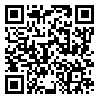Preventive Care in Nursing and Midwifery Journal
Mon, Aug 11, 2025
[Archive]
Volume 15, Issue 1 (1-2025)
PCNM 2025, 15(1): 33-40 |
Back to browse issues page
Ethics code: IR.IAU.SHIRAZ.REC.1403.282
Download citation:
BibTeX | RIS | EndNote | Medlars | ProCite | Reference Manager | RefWorks
Send citation to:



BibTeX | RIS | EndNote | Medlars | ProCite | Reference Manager | RefWorks
Send citation to:
Naziri A, Hooman F. he role of family functioning and emotional expressiveness in Predicting anxiety in adolescent girls. PCNM 2025; 15 (1) :33-40
URL: http://nmcjournal.zums.ac.ir/article-1-958-en.html
URL: http://nmcjournal.zums.ac.ir/article-1-958-en.html
he role of family functioning and emotional expressiveness in Predicting anxiety in adolescent girls
Department of Psychology, Shiraz Branch, Islamic Azad University, Shiraz, Iran , n.psyhoman@gmail.com
Abstract: (40 Views)
Background: Anxiety is a common mental health issue in adolescence, more frequently affecting girls, emphasizing the need to examine family factors such as family functioning and emotional expressiveness.
Objectives: This study aimed to evaluate how family functioning and emotional expressiveness predict anxiety levels in adolescent girls.
Methods: This descriptive-correlational study analyzed a population of female adolescents enrolled in the first year of high school (grades 7-9, ages 13-15) in Shiraz during the 2023-2024 academic year. A sample of 252 participants was selected using a multi-stage cluster sampling method. Data were collected through the Children’s Anxiety Scale, the McMaster Family Assessment Device (FAD), and the Emotional Expressivity Questionnaire (EEQ). The data were analyzed with Pearson’s correlation coefficient and stepwise regression using SPSS version 26.
Results: Findings revealed a significant negative correlation between family functioning and anxiety (r=-0.51, p<0.001), as well as between emotional expressiveness and anxiety (r=-0.46, p<0.001). Both family functioning and emotional expressiveness together explained 34% of the variance in anxiety (R²=0.34), with family functioning contributing more significantly.
Conclusion: This study finds that family functioning and emotional expressiveness are important predictors of lower anxiety levels in adolescent girls, collectively accounting for a significant portion of the variance. Family functioning seems to have a more vital influence, indicating that interventions focused on family dynamics could help reduce anxiety in this group.
Objectives: This study aimed to evaluate how family functioning and emotional expressiveness predict anxiety levels in adolescent girls.
Methods: This descriptive-correlational study analyzed a population of female adolescents enrolled in the first year of high school (grades 7-9, ages 13-15) in Shiraz during the 2023-2024 academic year. A sample of 252 participants was selected using a multi-stage cluster sampling method. Data were collected through the Children’s Anxiety Scale, the McMaster Family Assessment Device (FAD), and the Emotional Expressivity Questionnaire (EEQ). The data were analyzed with Pearson’s correlation coefficient and stepwise regression using SPSS version 26.
Results: Findings revealed a significant negative correlation between family functioning and anxiety (r=-0.51, p<0.001), as well as between emotional expressiveness and anxiety (r=-0.46, p<0.001). Both family functioning and emotional expressiveness together explained 34% of the variance in anxiety (R²=0.34), with family functioning contributing more significantly.
Conclusion: This study finds that family functioning and emotional expressiveness are important predictors of lower anxiety levels in adolescent girls, collectively accounting for a significant portion of the variance. Family functioning seems to have a more vital influence, indicating that interventions focused on family dynamics could help reduce anxiety in this group.
Type of Study: Orginal research |
Subject:
Nursing
Received: 2025/05/7 | Accepted: 2025/01/29 | Published: 2025/01/29
Received: 2025/05/7 | Accepted: 2025/01/29 | Published: 2025/01/29
Send email to the article author
| Rights and permissions | |
 |
This work is licensed under a Creative Commons Attribution-NonCommercial 4.0 International License. |




